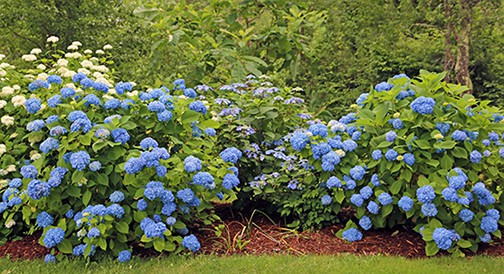
The plant on the left is ‘Endless Summer’ and the shrub on the right is ‘Penny Mac.’ They both flower on new and old growth but all the flowers you see in this photo were formed last year. The flowers on new wood won’t appear until later in the summer. In between these two shrubs is a fantastic lace-cap: ‘Twist n’ Shout.’
This is the question I hear from frustrated gardeners all over the country. Endless Summer and other repeat-flowering Hydrangeas were supposed to give gardeners in cold regions those same outrageous blue hydrangeas that we love so much on Cape Cod. They are supposed to flower on new growth and be, well, endless right?
Here’s what gardeners in colder regions (zone 5 and below) need to know. Hydrangeas that bloom on old and new growth – called “remontant” hydrangeas by plant geeks – do flower on new growth, but most of the flowers come from buds that were formed the summer before. In late-summer the plant forms the germ of the majority of its flowers for the next year. If you live in an area where the winter temperatures don’t go below 5 degrees Fahrenheit these buds will survive the cold and go on to bloom in mid-summer the following season.
But if you live where the temperatures drop to zero or below, those buds are killed by the cold. In zones 4 or 5 gardeners often find dead canes in the spring instead of stems with green buds. Yes, the plant lives through the winter, but the growth comes back from the ground, not the stems where future flowers were already formed.
The blooming problem can be further compounded by a short growing season. In colder parts of the country the flowers that are formed later in the fall on new growth might not have time to open before the first hard frost. So if you’re gardening in a cold zone 5 or below it’s possible that your Endless Summer might often be an Endless Exasperation.
Don’t get me wrong…I love these Hydrangeas that flower on both new and old wood. But these shrubs are just not the flower machine in Minnesota that they are on Cape Cod.

Hydrangea flowers last best when the plant is grown in morning sun and afternoon shade. Don’t let the flowers wilt or they will brown and disappear quickly.
If you want to grow an Endless Summer or one of the other repeat-blooming hydrangeas and you live in a zone 4 or 5, here are some tips for success.
- Find the warmest micro-climate on your property. This is the place where the snow melts first and the daffodils poke up and bloom before all other narcissus in your gardens. Plant the hydrangea here unless the sun bakes this space in the summer. Hydrangeas appreciate afternoon shade.
- You can try protecting those stems during the winter by building a cage around the plant out of stakes and chicken wire and filling it with hay or dried leaves. Put a piece of plastic over the top of this structure, but not on the sides. This will help keep the filling dryer. Take the covering off in April or whenever your nighttime temperatures stay more or less above 32.
- Grow some hydrangeas in pots and bring them into an unheated garage for the winter. Pull the pots into a protected area after the leaves have fallen but before the dirt freezes in the pots. As winter goes on, water them when the soil starts to dry. Pull the plants outside once the temperatures are reliably above 30 degrees. (Be prepared to pull them back inside if the forecast predicts lower temperatures.)
- Only cut out the dead stems…don’t prune canes that are living back, no matter what you see your neighbors doing.
- Be sure your plants are getting at least three hours of dead-on sun each day. If you have a location that gets morning sun and afternoon shade, that would be ideal.
- When all else fails, plan a summer trip to Cape Cod…here it’s practically a law that blue hydrangeas be planted in every landscape, and we celebrate our signature plant every July during the Cape Cod Hydrangea Festival.
